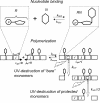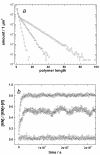Survival of the fittest before the beginning of life: selection of the first oligonucleotide-like polymers by UV light
- PMID: 12773209
- PMCID: PMC165426
- DOI: 10.1186/1471-2148-3-12
Survival of the fittest before the beginning of life: selection of the first oligonucleotide-like polymers by UV light
Abstract
Background: A key event in the origin of life on this planet has been formation of self-replicating RNA-type molecules, which were complex enough to undergo a Darwinian-type evolution (origin of the "RNA world"). However, so far there has been no explanation of how the first RNA-like biopolymers could originate and survive on the primordial Earth.
Results: As condensation of sugar phosphates and nitrogenous bases is thermodynamically unfavorable, these compounds, if ever formed, should have undergone rapid hydrolysis. Thus, formation of oligonucleotide-like structures could have happened only if and when these structures had some selective advantage over simpler compounds. It is well known that nitrogenous bases are powerful quenchers of UV quanta and effectively protect the pentose-phosphate backbones of RNA and DNA from UV cleavage. To check if such a protection could play a role in abiogenic evolution on the primordial Earth (in the absence of the UV-protecting ozone layer), we simulated, by using Monte Carlo approach, the formation of the first oligonucleotides under continuous UV illumination. The simulations confirmed that UV irradiation could have worked as a selective factor leading to a relative enrichment of the system in longer sugar-phosphate polymers carrying nitrogenous bases as UV-protectors. Partial funneling of the UV energy into the condensation reactions could provide a further boost for the oligomerization.
Conclusion: These results suggest that accumulation of the first polynucleotides could be explained by their abiogenic selection as the most UV-resistant biopolymers.
Figures


 = 30. The rate constants of nucleotide binding (kbind) and dissociation (kdiss) were 3 × 10-8 s-1 and 10-6 s-1, respectively (
= 30. The rate constants of nucleotide binding (kbind) and dissociation (kdiss) were 3 × 10-8 s-1 and 10-6 s-1, respectively ( = 3 × 10-2). Under the UV illumination, monomers decomposed with the rate constant of 3·10-3 s-1 irrespectively of their position in the chain. For simplicity, the UV protection factor U of 30 was used both for monomers and oligomers. The partial funneling of UV energy was assumed to increase the kbind value from 3 × 10-8s-1 up to 1.2 × 10-7 s-1. a, Polymer length distribution at equilibrium. b, Fraction of monomers protected by nitrogenous bases as a function of time.
= 3 × 10-2). Under the UV illumination, monomers decomposed with the rate constant of 3·10-3 s-1 irrespectively of their position in the chain. For simplicity, the UV protection factor U of 30 was used both for monomers and oligomers. The partial funneling of UV energy was assumed to increase the kbind value from 3 × 10-8s-1 up to 1.2 × 10-7 s-1. a, Polymer length distribution at equilibrium. b, Fraction of monomers protected by nitrogenous bases as a function of time.Similar articles
-
Montmorillonite protection of an UV-irradiated hairpin ribozyme: evolution of the RNA world in a mineral environment.BMC Evol Biol. 2007 Aug 16;7 Suppl 2(Suppl 2):S2. doi: 10.1186/1471-2148-7-S2-S2. BMC Evol Biol. 2007. PMID: 17767730 Free PMC article.
-
Biological Polymers: Evolution, Function, and Significance.Acc Chem Res. 2025 Mar 4;58(5):659-672. doi: 10.1021/acs.accounts.4c00546. Epub 2025 Feb 5. Acc Chem Res. 2025. PMID: 39905926 Free PMC article.
-
Planning Implications Related to Sterilization-Sensitive Science Investigations Associated with Mars Sample Return (MSR).Astrobiology. 2022 Jun;22(S1):S112-S164. doi: 10.1089/AST.2021.0113. Epub 2022 May 19. Astrobiology. 2022. PMID: 34904892
-
Physico-chemical and evolutionary constraints for the formation and selection of first biopolymers: towards the consensus paradigm of the abiogenic origin of life.Chem Biodivers. 2007 Sep;4(9):2003-15. doi: 10.1002/cbdv.200790167. Chem Biodivers. 2007. PMID: 17886857 Review.
-
[Prebiotic phosphate: a problem insoluble in water ? ].Riv Biol. 2005 Jan-Apr;98(1):18-23. Riv Biol. 2005. PMID: 15889337 Review. Italian.
Cited by
-
Life's Order, Complexity, Organization, and Its Thermodynamic-Holistic Imperatives.Life (Basel). 2012 Nov 13;2(4):323-63. doi: 10.3390/life2040323. Life (Basel). 2012. PMID: 25371269 Free PMC article.
-
Iron sulfide-catalyzed gaseous CO2 reduction and prebiotic carbon fixation in terrestrial hot springs.Nat Commun. 2024 Nov 28;15(1):10280. doi: 10.1038/s41467-024-54062-y. Nat Commun. 2024. PMID: 39609396 Free PMC article.
-
Montmorillonite protection of an UV-irradiated hairpin ribozyme: evolution of the RNA world in a mineral environment.BMC Evol Biol. 2007 Aug 16;7 Suppl 2(Suppl 2):S2. doi: 10.1186/1471-2148-7-S2-S2. BMC Evol Biol. 2007. PMID: 17767730 Free PMC article.
-
Sulfidic Anion Concentrations on Early Earth for Surficial Origins-of-Life Chemistry.Astrobiology. 2018 Aug;18(8):1023-1040. doi: 10.1089/ast.2017.1770. Epub 2018 Apr 8. Astrobiology. 2018. PMID: 29627997 Free PMC article.
-
On the origin of life in the zinc world: 1. Photosynthesizing, porous edifices built of hydrothermally precipitated zinc sulfide as cradles of life on Earth.Biol Direct. 2009 Aug 24;4:26. doi: 10.1186/1745-6150-4-26. Biol Direct. 2009. PMID: 19703272 Free PMC article.
References
Publication types
MeSH terms
Substances
Grants and funding
LinkOut - more resources
Full Text Sources
Other Literature Sources
Research Materials

